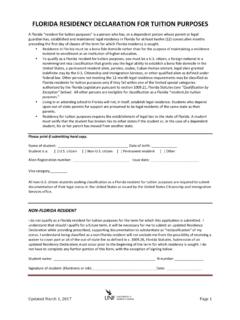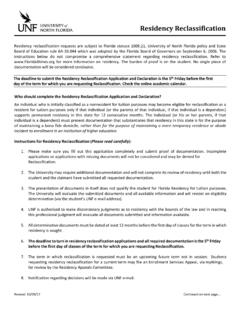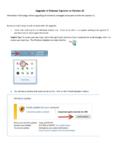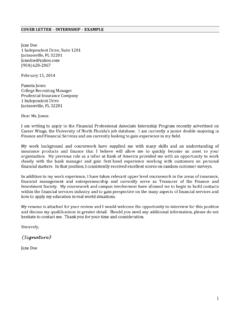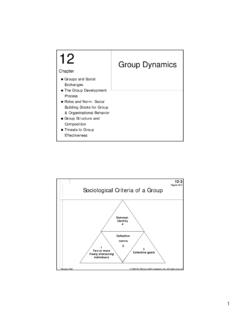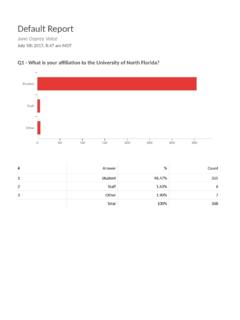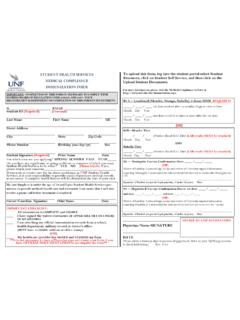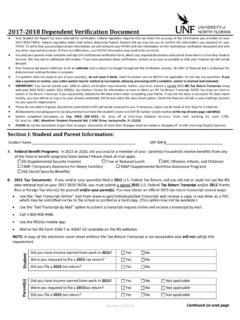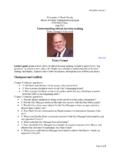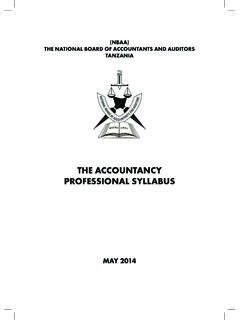Transcription of Chapter Seven - University of North Florida
1 Chapter SevenMotivation Through Needs,Job Design, and SatisfactionIrwin/McGraw-Hill 2001, The McGraw-Hill Companies, Inc. All Rights ReservedMotivation Defined7-2 Implications Associated with This Definition[Behavior is purposive rather than random-People exhibit both positive (work done on time) and negative (arrive late for work) behavior for a reason[Motivation arouses people to do something-People are unlikely to change a behavior or do something different unless they are motivated to do so[Motivation causes people to focus on a desired end-result or goal[Motivation fuels the persistence needed to exhibit sustained effort on a taskMotivation.]]]]
2 Psychological processes that cause the arousal direction, and persistence of voluntary actions that are goal 2001, The McGraw-Hill Companies, Inc. All Rights ReservedA Job Performance Model of Motivation7-3aFigure 7-1aAbility, Job knowledgeDispositions & TraitsEmotions, Moods, &AffectBeliefs & ValuesIndividual InputsPhysical EnvironmentTask DesignRewards & ReinforcementSupervisory Support &CoachingSocial NormsOrganizational CultureJob ContextArousal Attention Intensity& &Direction PersistenceMotivational ProcessesMotivatedBehaviorsSkillsEnable, LimitIrwin/McGraw-Hill 2001, The McGraw-Hill Companies, Inc. All Rights ReservedA Job Performance Model of Motivation (cont.)
3 7-3aFigure 7-1bIndividual InputsJob ContextMotivational ProcessesFocus: Direction, What we doIntensity: Effort, how hardwe tryQuality: Task strategies, theway we do itDuration: Persistence, howlong we stick to itSkillsEnable, LimitPerformanceMotivated BehaviorsIrwin/McGraw-Hill 2001, The McGraw-Hill Companies, Inc. All Rights ReservedHistorical Roots of Motivation TheoryFNeed theories are based on the premise that people are motivated by unmet or unsatisfied needs. We want what we don t theories are based on the idea that behavior is controlled by its consequences, not by internal states such as instincts, needs, emotions or theory is based on a different perspective or set of 2001, The McGraw-Hill Companies, Inc.
4 All Rights ReservedHistorical Roots of Motivation Theory (continued)FCognitive theories are based on the assumption that behavior is a function of beliefs, expectations, values, and other mental characteristics models of motivation are based on the notion that motivation is influenced by the type of tasks a person completes at work. FMotivation is proposed to be a function of an individual s feelings and emotions according to theories of feelings/emotions. 7-4bIrwin/McGraw-Hill 2001, The McGraw-Hill Companies, Inc. All Rights ReservedMaslow sNeed Hierarchy The McGraw-Hill Companies, Inc., 20017-6 Figure 7-3 Irwin/McGraw-HillPhysiologicalMost basic of the need to be desire to love and be for reputation, prestige, and recognition from for sERG ModelnGROWTHnRELATEDNESSnEXISTENCEnFRUST RATION-REGRESSIONnSelf-actualizationnEst eemnLovenSafetynPhysiologicalMcClelland s Need TheoryAchievement-motivated people prefer tasks of moderate ability situations in which their performance is due to their own efforts more feedback on their success and failures than do low achieversNeed For Affiliation: Desire to spend time in social relationships and For Power.
5 Desire to influence, coach, teach, or encourage others to For Achievement: Desire to excel and accomplish something 2001, The McGraw-Hill Companies, Inc. All Rights ReservedApproaches to Job DesignnScientific Management:-attempts to determine the most efficient way toperform positive and negative consequences resultfrom using this Enlargement:-puts more variety into a be used as part of a broader approach thatuses multiple job design Design: Changing the content and/or process of a specific job to increase job satisfaction and 2001, The McGraw-Hill Companies, Inc. All Rights ReservedApproaches to Job Design (continued)nJob Rotation:-moves employees from one specialized job of job rotation have not been Enrichment:-is based onHerzberg achievement, recognition, stimulatingwork, responsibility, and advancement into a principles of vertical loading to enrich a 2001, The McGraw-Hill Companies, Inc.
6 All Rights ReservedHerzberg s Motivator-Hygiene Model7-10aFigure 7-4aMotivatorsNo SatisfactionSatisfactionJobs that do notJobs offeringoffer achievementachievement,recognition,recog nition,stimulating work,stimulating work,responsibility,responsibility,and 2001, The McGraw-Hill Companies, Inc. All Rights ReservedHerzberg s Motivator-Hygiene Model (continued)7-10bFigure 7-4bHygiene FactorsDissatisfactionNo DissatisfactionJobs with poorJobs with goodcompany policies,company policies,and administration,and administration,technical supervisiontechnical supervision,salary, interpersonalsalary, interpersonalrelationships withrelationships withsupervisors, and supervisors, andworking 2001, The McGraw-Hill Companies, Inc.
7 All Rights ReservedPrinciples of Vertically Loading a Job7-11aTable 7-1aPrincipleMotivators InvolvedARemoving some controls while retaining accountabilityResponsibility andpersonal achievementBIncreasing the accountability of individuals for their own workResponsibility andrecognitionCGiving a person a complete natural unit of work (module, division, area,and so on)Responsibility,achievement, andrecognitionDGranting additional authority to an employee in his activity; jobfreedomResponsibility,achievement, andrecognitionSource: Reprinted by permission of the Harvard Business Review. An exhibit from One More Time: How Do You Motivate Employees?
8 By F Herzberg (January/February 1968). Copyright 1968 by the President and Fellows of Harvard College; all rights of Vertically Loading a Job (continued)7-11bTable 7-1bPrincipleMotivators InvolvedEMaking periodic reports directly available to the worker himselfrather than to the supervisorInternal recognitionFIntroducing new and more difficult tasks not previously handledGrowth and learningGAssigning individuals specific or specialized tasks, enabling them tobecome expertsResponsibility, growth,and advancementSource: Reprinted by permission of the Harvard Business Review. An exhibit from One More Time: How Do You Motivate Employees?
9 By F Herzberg (January/February 1968). Copyright 1968 by the President and Fellows of Harvard College; all rights Job Characteristics Model7-12 Outcomes*High internalwork motivation*High growthsatisfaction*High generaljob satisfaction*High workeffectivenessCriticalpsychologicalst ates*Experiencedmeaningfulness of thework*Experiencedresponsibility foroutcomes of the work*Knowledge of the actualresults of the workactivitiesCore jobcharacteristics*Skill variety*Task identity*Tasksignificance*Autonomy*Feedb ack fromjobModerators1. Knowledge and skill2. Growth need strength3. Context satisfactionsIrwin/McGraw-Hill 2001, The McGraw-Hill Companies, Inc.
10 All Rights ReservedMotivating Potential of a Job7-13 MPS = X Autonomy X FeedbackSkill Task TaskVariety + Identity + Significance3 Irwin/McGraw-Hill 2001, The McGraw-Hill Companies, Inc. All Rights ReservedCauses of Job SatisfactionnNeed Fulfillment: Satisfaction is based on the extent to which a job satisfies a person s needsnDiscrepancies: Satisfaction is determined by the extent to which an individual receives what he or she expects from a Attainment: Satisfaction results from the extent to which a job allows fulfillment of one s work : Satisfaction is a function of how fairly an individual is treated at Components: Satisfaction is partly a function of personal traits and genetic Satisfaction: An affective or emotional response to various facets of one s 2001, The McGraw-Hill Companies, Inc.
